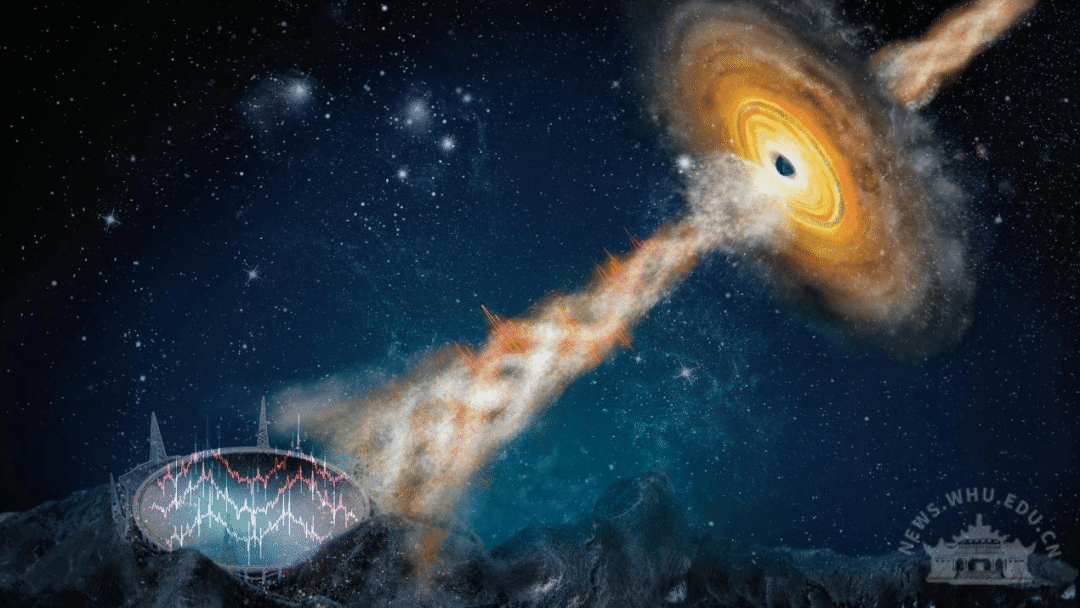Nature recently published the latest research results on black holes by Prof. Wang Wei’s team from the Department of Astronomy, School of Physics and Technology, Wuhan University.
The paper is entitled “Sub-second periodic radio oscillations in a microquasar”. Wuhan University is the first author, while. Prof. Tian Pengfu, Zhang Ping, and Wang Wei from Wuhan University and PhD student Wang Pei from the National Astronomical Observatories of the Chinese Academy of Sciences (NAOC) are its co-first authors. Prof. Wang Wei and Prof. Zhang Bing from the University of Nevada, USA are the co-corresponding authors. Prof. Chen Jiashi, Chen Xiao, Sai Na and Zhu Zonghong from Wuhan University are its co-authors.
A microquasar is a binary system in the Galaxy consisting of a neutron star or black hole and an ordinary star. The neutron star or black hole accretes material from the star to produce a high-temperature accretion disk and relativistic jets, which are manifested observationally as intermittent or long-varying X-ray and radio radiation. It is a natural laboratory of the universe for the study of strong gravitational fields and relativistic physics.

The Five-hundred-meter Aperture Spherical Radio Telescope (FAST) in China unveiled mysterious radio pulse signals from a black hole for the first time.
GRS 1915 + 105 is a well-known microquasar with a fast-spinning black-hole, from which superluminal motion of radio jets is observed, making it an important sample to study extreme high-energy physical processes. For nearly 30 years since its discovery, the black hole has exhibited rich X-ray light variation features and intermittent radio jets, but the jet dynamics of the black hole and the origin of the fast variability are still unclear. In order to unravel the mystery of the relativistic jets of the microquasar, the research team has monitored continuous radiation spectrum variability with high temporal precision (sample time of 49 microseconds) of the black hole for the first time from 2020 to 2022 by the use of the China Tianyan, a five-hundred-meter-aperture spherical radio telescope (FAST). With FAST’s high sampling and detection sensitivity, two observations made in January 2021 and June 2022 revealed the presence of a weak radio pulse in the black hole with a pulse period of about 0.2 seconds. This pulse period is unstable and mostly undetectable, hence the term quasi-periodic oscillation.

Group photo of Prof. Wang Wei’s team
This is the first time in the world that a sub-second low-frequency radio quasi-periodic oscillation has been observed in a microquasar, and it reveals that the quasi-periodic oscillation in a black hole system is directly related to relativistic jets. The discovery of the radio pulse in the black hole is of great scientific significance for revealing the origin of relativistic radio jets in compact objects and the process of dynamics, which will provide a new way for black hole radio observation and theoretical research.
Wang Wei’s team has been dedicated to the research of compact objects and high-energy astrophysical phenomena. They carry out multi-band astronomical observations and scientific discoveries by utilizing FAST, scientific satellite of the Insight, LAMOST, and have published more than 50 papers in international first-class astronomical journals, such as Nature and its sub-journals, in the past five years. The research is supported by the National Key Research and Development Program of China and the Key Program of the National Natural Science Foundation of China.
Rewritten by Xiong Shuya
Edited by Ma Shuqi, Sylvia, Xi Bingqing